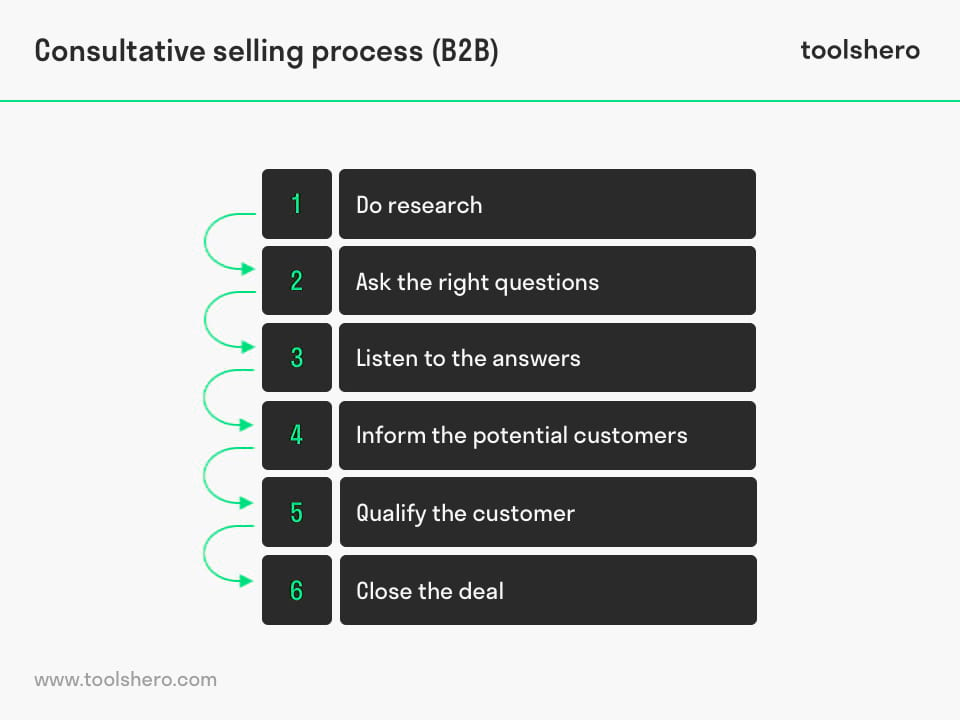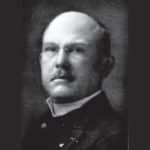Consultative Selling Techniques

Consultative Selling: this article provides a practical explanation of consultative selling. It covers what consultative selling is, provides examples and explores different techniques. It also provides the steps of the consultative selling approach and concludes with a summary. After reading this article, you’ll understand the basics of this marketing tool. Enjoy reading!
What is Consultative Selling?
Consultative selling can be defined as a sales technique in which the seller acts as an adviser. The buyer is assisted in identifying his or her needs and then the seller offers products that meet these needs.
It’s different from traditional sales, because the seller suggests an option as a solution to the buyer’s problem and isn’t focused on selling a specific product. The goal of consultative selling is to increase openness to help the seller gain useful insight in the customer’s needs.
The term was first described in the seventies in the book Consultative Selling by Mack Hanan. This book deals with a sales technique in which the seller acts as a consultant for his or her prospects and asks questions to determine what exactly the prospect needs. The seller then uses this information to select the best possible product or service that matches this.
This selling technique goes hand in hand with other sales techniques, such as value-based selling. Here the seller presents specific benefits of his product or service.
This sales technique ensures that the customer shares a lot of information about his needs, so it is then easy for the seller to combine those desires with benefits of the product he or she sells.
Consultative Selling Example (B2C)
Car salesman Philip uses a traditional sales technique. When people walk into his showroom, he immediately asks what they’re looking for.
The moment he has an answer, a small car for instance, he immediately shows a newly arrived small car. Once the people show interest, Philip decides to immediately employ his skills to make a deal. His goal is to complete the sale quickly and to send the customers on their way with their new car.
Salesman Richard uses the consultative selling method. When customers enter the showroom, he takes the time to get to know the wishes and needs of the customer. Interested, Richard asks what the customer thinks they’ll be using his car for, and how often.
Richard carefully explains all the options and guides them to three different options that all match the customer’s wishes. Because the customer indicates to mainly need the car for commuting within the city, Richard also recommends a small electric car. His goal is to find the product that best fits the customer’s needs.
Consultative selling for business-to-business (B2B) is explained later on in this article.
Consultative Selling Techniques
The consultative selling method consists of several techniques. A few of these are explained below.
Alternate questions and advice
For the consultative seller the sales process starts with understanding the needs and wishes of the customer. The complete picture of these wishes is important for the seller because this is how a fitting solution for the customer’s problem can be found.
However, asking too many questions takes a lot of time, and may lead to the customer feeling interrogated. So alternate questions with giving advice. Advice is the basis for more questions, and it increases credibility and involvement.
Be reliable and decisive
Building trust with customers isn’t easy, especially not when it concerns sales conversations by phone or other media. Sellers can clear this hurdle by developing trust based on knowledge. This means that the seller’s words are consistent with his actions. A follow-up conversation contributes to this, amongst other things.
Encourage feedback
Feedback is the way for the seller to get to know more about the customer’s needs and wishes. When a customer expresses a concern or disagreement to the seller, it clarifies the needs and what they are and aren’t looking for in a product or service. Every bit of feedback therefore must considered.
Consultative Selling Approach (B2B)
The consultative selling approach and process can be summarised in six steps.

Figure 1 – Consultative Selling Approach (B2B)
1. Do research
The research phase of consultative selling includes the use of information about the potential customer. Marketing departments are concerned with inbound marketing and possess useful information, such as the size of a company, social media channels, and other lead information.
This information is important because the seller gives a general impression of the organisation.
2. Ask the right questions
From the first moment the seller and the customer come into contact, it’s important that the seller asks the right open questions. This contributes to building trust and provides broader insight into the customer’s needs and wishes. The goal of asking open questions is to slowly discover what the goals of the lead are.
3. Listen to the answers
Active listening to the customer is central in consultative selling. Focus on what the customer is saying and repeat their words to get confirmation. All information that’s gained helps in closing the deal.
4. Inform the potential customers
While actively listening to the customer, the seller needs to look for moments to inform the customer about the product or service. Here, it’s important that the customer sees how the option relates to their wishes and needs.
Ensure a balance between sharing knowledge and asking questions. The focus stays on helping the customer during the entire consultative selling process.
5. Qualify the customer
Qualifying is the process in which the seller confirms whether a lead really is a prospect. A prospect is a lead that has the potential of becoming a customer. A qualified lead has a plan, challenges, budget, timeline, and preferences. The sooner a lead is qualified, the better.
6. Close the deal
Because of the nature of consultative selling, it’s reasonably easy for the seller to turn the qualified lead into a customer by closing the deal. The entire process is focussed on helping and building trust, the qualified lead will therefore make the purchase sooner than with a sales method in which the options are pushed through.
Consultative Selling Summary
Consultative selling is a sales technique used by sales professionals in which they act primarily as advisors to the customer. The goal of this technique is to create an open and honest sales environment, in which the client and their needs are central.
The sales technique is consistent with other sales techniques, such as value-based selling. The information that consumers share with the salesperson regarding their needs is valuable input for the sales team when developing or expanding companies’ assortments.
Elements in consultative sales include asking focussed questions, listening to the customer, recommending several options, and closing the deal.
The consultative sales process begins by identifying a customer’s needs, then attempting to recommend products that fit those needs.
Identifying these needs should not be done by asking a very long series of questions. This takes too much time and makes the customer feel questioned. Therefore, alternate questions with advice.
In addition, it is important to be decisive and reliable as a salesperson. This includes being consistent with actions and responses. This includes having a follow-up conversation with the customer.
Consultative selling can be applied in business-to-consumer (B2C) and business-to-business (B2B).
When doing business between companies, it’s important that the inbound marketing of the organisation is in order and sufficient information about the lead is known in advance. Based on this knowledge, the B2B seller slowly explores all the customer’s needs and wishes.
Now It’s Your Turn
What do you think? Do you recognise the explanation about consultative selling? Which sales techniques do you use? What do you think is also important when helping the customer with their problem? Do you see similarities with other sales techniques? Do you have any tips or additional comments?
Share your experience and knowledge in the comments box below.
More information
- Hanan, M. (1993). Consultative selling. AMACOM Div American Mgmt Assn.
- Moncrief, W. C., & Marshall, G. W. (2005). The evolution of the seven steps of selling. Industrial Marketing Management, 34(1), 13-22.
- Rackham, N., & DeVincentis, J. (1998). Rethinking the sales force: Refining selling to create and capture customer value. Pennsylvania, NY: McGraw-Hill.
- Weitz, B. A., Castleberry, S. B., & Tanner, J. F. (2004). Selling: building partnerships.
How to cite this article:
Janse, B. (2019). Consultative Selling Techniques. Retrieved [insert date] from Toolshero: https://www.toolshero.com/marketing/consultative-selling/
Original publication date: 12/29/2019 | Last update: 08/22/2023
Add a link to this page on your website:
<a href=”https://www.toolshero.com/marketing/consultative-selling/”>Toolshero: Consultative Selling Techniques</a>












